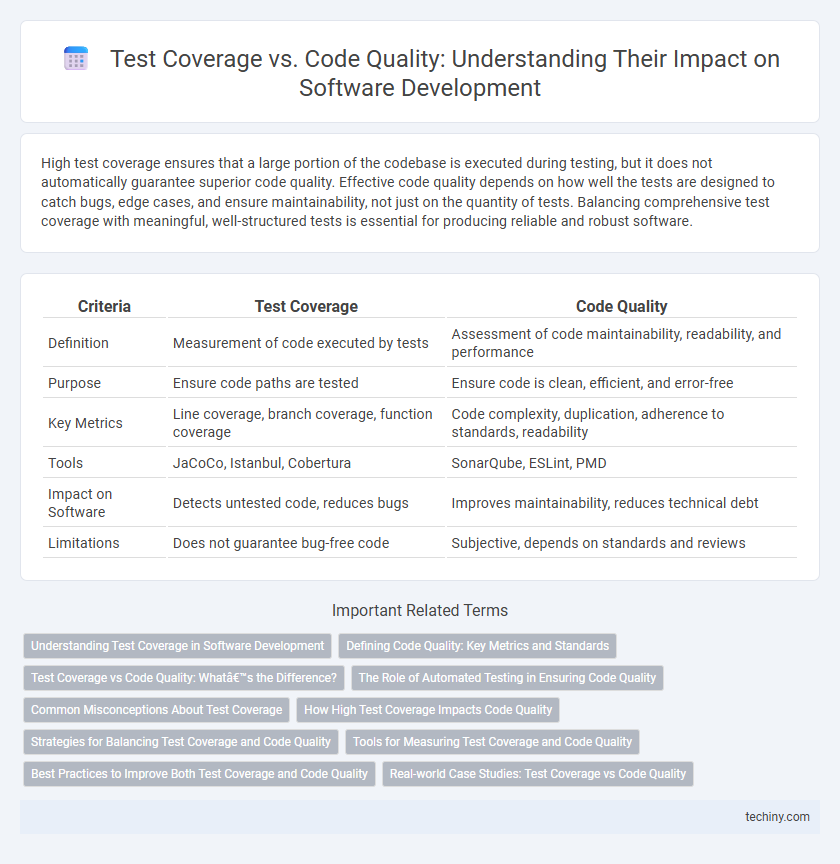High test coverage ensures that a large portion of the codebase is executed during testing, but it does not automatically guarantee superior code quality. Effective code quality depends on how well the tests are designed to catch bugs, edge cases, and ensure maintainability, not just on the quantity of tests. Balancing comprehensive test coverage with meaningful, well-structured tests is essential for producing reliable and robust software.
Table of Comparison
| Criteria | Test Coverage | Code Quality |
|---|---|---|
| Definition | Measurement of code executed by tests | Assessment of code maintainability, readability, and performance |
| Purpose | Ensure code paths are tested | Ensure code is clean, efficient, and error-free |
| Key Metrics | Line coverage, branch coverage, function coverage | Code complexity, duplication, adherence to standards, readability |
| Tools | JaCoCo, Istanbul, Cobertura | SonarQube, ESLint, PMD |
| Impact on Software | Detects untested code, reduces bugs | Improves maintainability, reduces technical debt |
| Limitations | Does not guarantee bug-free code | Subjective, depends on standards and reviews |
Understanding Test Coverage in Software Development
Test coverage measures the percentage of source code executed by automated tests, providing insight into which parts of the codebase are tested and which remain untested. High test coverage helps identify gaps in testing, but it does not guarantee code quality, as it does not assess test effectiveness or code maintainability directly. Understanding test coverage metrics enables development teams to balance thorough testing with code refactoring and quality improvements for robust software delivery.
Defining Code Quality: Key Metrics and Standards
Code quality is defined by key metrics such as maintainability, readability, and defect density, which ensure the software meets functional and performance requirements. Standards like the ISO/IEC 25010 framework and static code analysis tools are essential for objectively measuring code quality. High test coverage supports quality by validating code functionality but must be supplemented with metrics that assess complexity and adherence to coding standards.
Test Coverage vs Code Quality: What’s the Difference?
Test coverage measures the percentage of source code executed during testing, providing a quantitative metric for identifying untested parts of an application. Code quality encompasses broader attributes such as maintainability, readability, and defect density, reflecting the overall health and robustness of the software. High test coverage does not guarantee superior code quality, as thorough testing complements but does not replace clean, well-structured, and efficient code.
The Role of Automated Testing in Ensuring Code Quality
Automated testing plays a critical role in ensuring code quality by systematically verifying that software functions as intended, reducing human error, and enabling rapid feedback on code changes. High test coverage achieved through automated tests increases confidence in the software's reliability and maintainability while uncovering edge cases that manual testing might miss. Tools such as unit testing frameworks, integration tests, and continuous integration pipelines enhance code quality by enforcing consistent validation throughout the development lifecycle.
Common Misconceptions About Test Coverage
Test coverage measures the percentage of code executed by automated tests but does not guarantee high code quality or the absence of defects. High test coverage can exist alongside poorly designed, inefficient, or buggy code if tests lack depth or fail to validate edge cases and logical correctness. Relying solely on test coverage metrics without assessing test effectiveness and code maintainability often leads to a false sense of security in software quality assurance.
How High Test Coverage Impacts Code Quality
High test coverage enhances code quality by ensuring that a larger portion of the codebase undergoes rigorous validation, minimizing the presence of undetected bugs and logical errors. Comprehensive testing frameworks, such as unit tests, integration tests, and end-to-end tests, contribute to maintainable and robust software by verifying code correctness and facilitating early defect discovery. Elevated test coverage metrics correlate with reduced post-release failures, increased developer confidence, and streamlined code refactoring processes.
Strategies for Balancing Test Coverage and Code Quality
Effective strategies for balancing test coverage and code quality involve prioritizing critical code paths for comprehensive testing while applying static code analysis tools to identify potential defects and maintain coding standards. Incorporating automated unit and integration tests ensures consistent validation of functionality, whereas peer code reviews enhance readability and maintainability. Leveraging metrics such as mutation testing and code complexity analysis helps optimize test efforts without compromising the overall quality of the software.
Tools for Measuring Test Coverage and Code Quality
Tools for measuring test coverage like JaCoCo, Coveralls, and Istanbul provide precise metrics on the percentage of code executed during testing, enabling developers to identify untested code paths. Code quality tools such as SonarQube, ESLint, and CodeClimate analyze static code attributes, including maintainability, complexity, and potential bugs, to ensure adherence to coding standards. Integrating these tools into continuous integration pipelines enhances overall software reliability by combining quantitative test coverage data with qualitative code quality assessments.
Best Practices to Improve Both Test Coverage and Code Quality
Implement comprehensive unit and integration tests using tools like Jest or JUnit to increase test coverage while maintaining high code quality standards. Employ static code analysis tools such as SonarQube to detect potential bugs and enforce coding conventions, ensuring robust and maintainable code. Incorporate continuous integration pipelines to automate tests and code reviews, enabling early defect detection and consistent performance monitoring.
Real-world Case Studies: Test Coverage vs Code Quality
Real-world case studies demonstrate that high test coverage does not always guarantee superior code quality, emphasizing the importance of test effectiveness and code maintainability. Projects with extensive automated test suites but poor refactoring practices often experience diminishing returns in defect detection and system reliability. Analyzing industry benchmarks reveals that balanced investment in both comprehensive testing and continuous quality improvement yields the best software outcomes.
Test Coverage vs Code Quality Infographic

 techiny.com
techiny.com